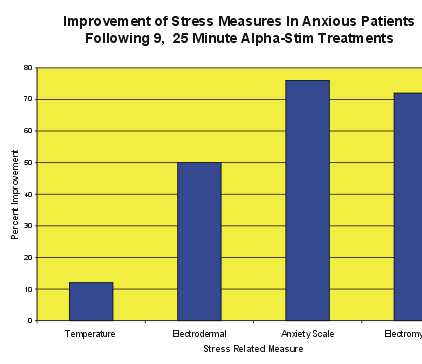Overcash, Stephen J. A retrospective study to determine the effect of cranial electrotherapy stimulation (CES) on patients suffering from anxiety disorders. American Journal of Electromedicine, 16(1):49-51, 1999.
197 patients diagnosed with anxiety disorders (DSM 300.02, 308.3, 300.00), referred by local physicians, and given an average of 8.9, 25 minute Alpha-Stim CES treatments at 0.5 Hz in conjunction with other treatments from 1989 to 1995 were evaluated. Over 80% of the patients were also provided with an Alpha-Stim on loan to take home and use daily or twice a day. 15 patients did not complete the program, primarily for financial reasons. Of the 182 who completed the prescribed course of therapy, 55 were male, 127 were female, with an average age of 35.6. 26% had unsuccessful treatment with anxiolytic medication. 16% had used antidepressant medications, alcohol, individual psychotherapy or behavior modification therapy. 58% had no previous therapy for their anxiety disorder. All patients were asked to rate their present anxiety on a 0 - 100 scale, with 100 being the highest amount of anxiety they could imagine. Post treatment assessments were made at the beginning of their last session. Pre and post treatment assessments were also made for some patients on 3 objective physiological measures, electromyogram (EMG), electrodermal response (EDR), and peripheral temperature (temp). 73 patients had EMG evaluations, and an average of 8.6 treatments. The EMG group dropped from a pretreatment mean of 15.8 µV to a post treatment of 4.5 µV. 83 patients had EDR evaluations, and an average of 7.4 treatments. The EDR group dropped from a pretreatment mean of 14.6 to a post treatment of 7.6. 26 patients had temperature evaluations, and an average of 12.6 treatments. The temperature group rose from a pretreatment mean of 81.2º F to a post treatment of 92.1º F. The subjective 0 - 100 scale for all 182 patients dropped form 62.3 to 14.8. The results were subjected to a paired t-test. There was significant (P<.05) positive changes on all objective and subjective criteria. The mean differences were 9.10 ± 2.00 µV for the EMG analysis, 6.89 ± 1.08 for the EDR, 9.91º F ± 2.69 for the temp, and 27.46 ± 16.34 for the 0 - 100 scale. There was a significant correlation (86%) between the perceived anxiety ratings and the objective measures. No patients were on any anxiolytic or antidepressant medication when they left treatment successfully.
At a 6 - 8 month follow-up 73% of the patients were “well satisfied” with their treatment and had no significant regression or other anxiety disorders, 18% were “satisfied” but had some problem with anxiety since they stopped the treatment, and 9% chose not to respond, had significant symptoms since they stopped the treatment, or in 1 case, “was not satisfied” with the treatment. There was no reported negative side effects (short or long term). The author noted that the results are immediate in most cases, and that the CES treatment seems to have long lasting results as long as the patient is given a minimum of 4 - 6 treatments. Note: this follow-up is from the author’s original manuscript. It did not appear in the published study.
|
